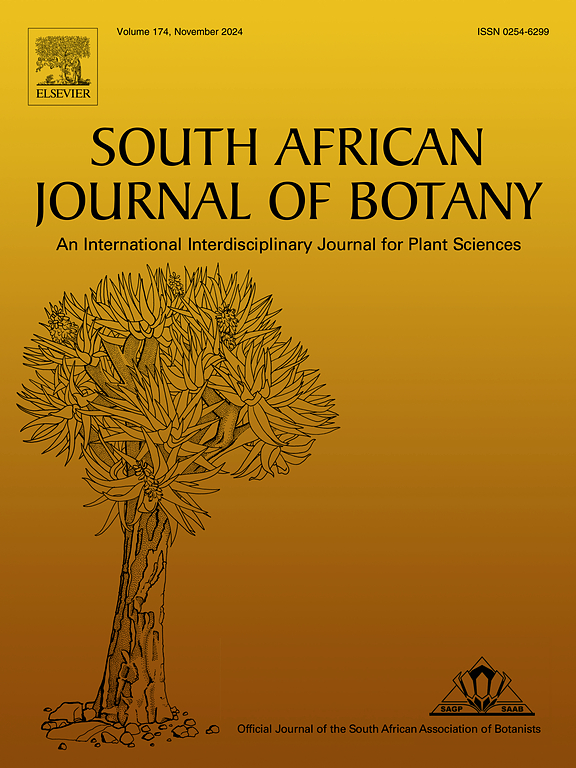HPLC-PDA验证富黄酮木瓜治疗血小板减少症的网络药理学及保护作用
IF 2.7
3区 生物学
Q2 PLANT SCIENCES
引用次数: 0
摘要
通过蚊子叮咬传播的登革热病毒会引起一系列疾病,从轻微的感冒症状到严重的出血热或登革热休克综合征,这些症状可能是致命的。严重登革热感染的主要临床指标之一是血小板减少,血小板计数明显下降。传统上,卡里卡木瓜叶汁(CPLJ)被认为是一种很有前途的促血小板药物。本研究旨在系统评价新鲜CPLJ生物活性丁醇组分(BBF)的非靶向代谢组学分析。采用高效液相色谱法测定多酚含量,并对HepG2和HEK 293细胞株进行细胞毒性研究。采用网络药理学分析探讨多酚促进登革热患者血小板恢复的多机制。用高效液相色谱法对BBF和BEF中6种代谢物进行了鉴定和定量。BBF和BEF对HepG2细胞具有较高的细胞毒性,对HEK 293细胞具有抑制作用,而对HEK 293细胞具有促进增殖的作用,IC50值最高。进一步通过网络药理学,这六种量化的植物化合物在登革热相关的血小板减少症中表现出多种生理作用,重点是它们的药物样特性,以及与TLR4、RELA、MAPK1等靶点的相互作用。由此得出结论,槲皮素、反式阿魏酸和山奈酚等植物化合物通过与TLR4的相互作用,可能成为减少登革热感染者血小板减少症的有希望的药物。这些化合物在通过体外试验验证其疗效和药效后,可作为治疗登革热相关血小板减少症的药物。BBF和BEF可作为植物药用于增强血小板,无论是作为独立治疗或辅助。本文章由计算机程序翻译,如有差异,请以英文原文为准。

Network pharmacology and protective effect of HPLC-PDA validated flavonoid rich Carica papaya for the treatment of thrombocytopenia
The dengue virus transmitted through mosquito bites causes a series of ailments ranging from mild-cold like symptoms to severe haemorrhagic fever or dengue shock syndrome, which can be fatal. One of the major clinical indicators of severe dengue infection is thrombocytopenia, a significant drop in platelet count Traditionally, Carica papaya leaf juice (CPLJ) has been regarded as a promising platelet enhancing remedy in dengue fever. The present study was aimed to systematically evaluate the untargeted metabolomic analysis of bioactive butanol fraction (BBF) of fresh CPLJ. For polyphenol quantification, HPLC analysis was used, followed by cytotoxicity studies in HepG2 and HEK 293 cell lines. Network pharmacological analysis was used to investigate the multi-mechanism of polyphenols in promoting platelet recovery in dengue. Six metabolites were identified and quantified by HPLC in both BBF and Bioactive ethanol fraction (BEF). The BBF and BEF showed relatively high cytotoxicity in HepG2 demonstrating inhibition whereas in HEK 293 cells, they promoted proliferation,exhibiting the highest IC50 values. Further through network pharmacology, the six quantified phytocompounds demonstrated multiple physiological roles in dengue associated thrombocytopenia with an emphasis on their drug-like properties, and interactions with targetssuch as TLR4, RELA, MAPK1 etc. Thus, it was concluded that through interaction with TLR4, phytocompounds such as quercetin, trans ferulic acid, and kaempferol may serve as promising agents by reducing thrombocytopenia in dengue-infected individuals. These compounds can be used as drugs to treat dengue-associated thrombocytopenia after verifying their efficacy and drug potency through in-vitro assays. BBF and BEF can be used as phytopharmaceuticals for the enhancement of platelets, either as standalone treatments or adjuvants.
求助全文
通过发布文献求助,成功后即可免费获取论文全文。
去求助
来源期刊

South African Journal of Botany
生物-植物科学
CiteScore
5.20
自引率
9.70%
发文量
709
审稿时长
61 days
期刊介绍:
The South African Journal of Botany publishes original papers that deal with the classification, biodiversity, morphology, physiology, molecular biology, ecology, biotechnology, ethnobotany and other botanically related aspects of species that are of importance to southern Africa. Manuscripts dealing with significant new findings on other species of the world and general botanical principles will also be considered and are encouraged.
 求助内容:
求助内容: 应助结果提醒方式:
应助结果提醒方式:


